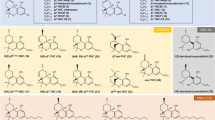Abstract
Purpose
Many bioactive molecules show a type of solution phase behavior, termed promiscuous aggregation, whereby at micromolar concentrations, colloidal drug-rich aggregates are formed in aqueous solution. These aggregates are known to be a major cause of false positives and false negatives in select enzymatic high-throughput screening assays. The goal of this study was to investigate the impact of drug-rich aggregates on in vitro drug screening metabolism assays.
Methods
Cilnidipine was selected as an aggregate former and its impact on drug metabolism was evaluated against rCYP2D6, rCYP1A2, rCYP2C9 and human liver microsomes.
Results
The cilnidipine aggregates were shown to non-specifically inhibit multiple cytochrome P450 enzymes with an IC50 comparable with the IC50 of potent model inhibitors.
Conclusions
This newly demonstrated mode of “promiscuous inhibition” is of great importance as it can lead to false positives during drug metabolism evaluations and thus it needs to be considered in the future to better predict in vivo drug-drug interactions.




Similar content being viewed by others
Abbreviations
- CAC:
-
Critical aggregation concentration
- DDI:
-
Drug-drug interactions
- HLM:
-
Human liver microsomes
- HPLC:
-
High performance liquid chromatography
References
Galetin A, Gertz M, Houston JB. Potential role of intestinal first-pass metabolism in the prediction of drug–drug interactions. Expert Opin Drug Metab Toxicol. 2008;4(7):909–22. https://doi.org/10.1517/17425255.4.7.909.
Bjornsson TD, Callaghan JT, Einolf HJ, Fischer V, Gan L, Grimm S, et al. The conduct of in vitro and in vivo drug-drug interaction studies: a pharmaceutical research and manufacturers of america (PhRMA) perspective. Drug Metab Dispos. 2003;31(7):815 LP–832.
Bjornsson TD, Callaghan JT, Einolf HJ, Fischer V, Gan L, Grimm S, et al. The conduct of in vitro and in vivo drug-drug interaction studies: a PhRMA perspective. J Clin Pharmacol. 2003;43(5):443–69. https://doi.org/10.1177/0091270003252519.
Mao J, Mohutsky MA, Harrelson JP, Wrighton SA, Hall SD. Prediction of CYP3A-mediated drug-drug interactions using human hepatocytes suspended in human plasma. Drug Metab Dispos. 2011;39(4):591 LP–602.
Xu L, Chen Y, Pan Y, Skiles GL, Shou M. Prediction of human drug-drug interactions from time-dependent inactivation of CYP3A4 in primary hepatocytes using a population-based simulator. Drug Metab Dispos. 2009;37(12):2330 LP–2339.
Feng BY, Simeonov A, Jadhav A, Babaoglu K, Inglese J, Shoichet BK, et al. A high-throughput screen for aggregation-based inhibition in a large compound library. J Med Chem. 2007;50(10):2385–90. https://doi.org/10.1021/jm061317y.
McGovern SL, Caselli E, Grigorieff N, Shoichet BK. A common mechanism underlying promiscuous inhibitors from virtual and high-throughput screening. J Med Chem. 2002;45(8):1712–22. https://doi.org/10.1021/jm010533y.
McGovern SL, Helfand BT, Feng B, Shoichet BK. A specific mechanism of nonspecific inhibition. J Med Chem. 2003;46(20):4265–72. https://doi.org/10.1021/jm030266r.
Seidler J, McGovern SL, Doman TN, Shoichet BK. Identification and prediction of promiscuous aggregating inhibitors among known drugs. J Med Chem. 2003;46(21):4477–86. https://doi.org/10.1021/jm030191r.
Feng BY, Shelat A, Doman TN, Guy RK, Shoichet BK. High-throughput assays for promiscuous inhibitors. Nat Chem Biol. 2005;1:146.
Feng BY, Shoichet BK. A detergent-based assay for the detection of promiscuous inhibitors. Nat Protoc. 2006;1(2):550–3. https://doi.org/10.1038/nprot.2006.77.
Coan KED, Shoichet BK. Stoichiometry and physical chemistry of promiscuous aggregate-based inhibitors. J Am Chem Soc. 2008;130(29):9606–12. https://doi.org/10.1021/ja802977h.
Doak AK, Wille H, Prusiner SB, Shoichet BK. Colloid formation by drugs in simulated intestinal fluid. J Med Chem. 2010;53(10):4259–65. https://doi.org/10.1021/jm100254w.
Coan KED, Maltby DA, Burlingame AL, Shoichet BK. Promiscuous aggregate-based inhibitors promote enzyme unfolding. J Med Chem. 2009;52(7):2067–75. https://doi.org/10.1021/jm801605r.
Sassano MF, Doak AK, Roth BL, Shoichet BK. Colloidal aggregation causes inhibition of G protein-coupled receptors. J Med Chem. 2013;56(6):2406–14. https://doi.org/10.1021/jm301749y.
Owen SC, Doak AK, Wassam P, Shoichet MS, Shoichet BK. Colloidal aggregation affects the efficacy of anticancer drugs in cell culture. ACS Chem Biol. 2012;7:1429–35.
Kirchmair J, Göller AH, Lang D, Kunze J, Testa B, Wilson ID, et al. Predicting drug metabolism: experiment and/or computation? Nat Rev Drug Discov. 2015;14:387.
Trasi NS, Taylor LS. Thermodynamics of highly supersaturated aqueous solutions of poorly water-soluble drugs - impact of a second drug on the solution Phase behavior and implications for combination products. J Pharm Sci. 2015;104(8):2583–93. https://doi.org/10.1002/jps.24528.
Alhalaweh A, Bergström CAS, Taylor LS. Compromised in vitro dissolution and membrane transport of multidrug amorphous formulations. J Control Release. 2016;229:172–82. https://doi.org/10.1016/j.jconrel.2016.03.028.
Lindfors L, Forssén S, Skantze P, Skantze U, Zackrisson A, Olsson U. Amorphous drug nanosuspensions. 2. Experimental determination of bulk monomer concentrations. Langmuir. 2006;22(3):911–6. https://doi.org/10.1021/la052367t.
Raina SA, Alonzo DE, Zhang GGZ, Gao Y, Taylor LS. Using environment-sensitive fluorescent probes to characterize liquid-liquid phase separation in supersaturated solutions of poorly water soluble compounds. Pharm Res. 2015;32(11):3660–73. https://doi.org/10.1007/s11095-015-1725-z.
Emoto C, Iwasaki K. Approach to predict the contribution of cytochrome P450 enzymes to drug metabolism in the early drug-discovery stage: the effect of the expression of cytochrome B5 with recombinant P450 enzymes. Xenobiotica. 2007;37(9):986–99. https://doi.org/10.1080/00498250701620692.
Tres F, Hall SD, Mohutsky MA, Taylor LS. Monitoring the phase behavior of supersaturated solutions of poorly water-soluble drugs using fluorescence techniques. J Pharm Sci. 2018;107(1):94–102.
Simpson NJ, Solid-Phase K. Extraction: principles, techniques, and applications. Marcel Dekker, Inc: New York; 2000.
Baird JA, Van Eerdenbrugh B, Taylor LS. A classification system to assess the crystallization tendency of organic molecules from undercooled melts. J Pharm Sci. 2010;99(9):3787–806. https://doi.org/10.1002/jps.22197.
Loftsson T, Vogensen SB, Desbos C, Jansook P. Carvedilol: solubilization and cyclodextrin complexation: a technical note. AAPS PharmSciTech. 2008;9(2):425–30. https://doi.org/10.1208/s12249-008-9055-7.
Karjalainen MJ, Neuvonen PJ, Backman JT. In vitro inhibition of CYP1A2 by model inhibitors, anti-inflammatory analgesics and female sex steroids: predictability of in vivo interactions. Basic Clin Pharmacol Toxicol. 2008;103(2):157–65. https://doi.org/10.1111/j.1742-7843.2008.00252.x.
Acknowledgments
The authors wish to acknowledge Eli Lilly and Co. for funding through the LRAP program.
Author information
Authors and Affiliations
Corresponding author
Additional information
Publisher’s Note
Springer Nature remains neutral with regard to jurisdictional claims in published maps and institutional affiliations.
Rights and permissions
About this article
Cite this article
Tres, F., Posada, M.M., Hall, S.D. et al. The Effect of Promiscuous Aggregation on in Vitro Drug Metabolism Assays. Pharm Res 36, 170 (2019). https://doi.org/10.1007/s11095-019-2713-5
Received:
Accepted:
Published:
DOI: https://doi.org/10.1007/s11095-019-2713-5




